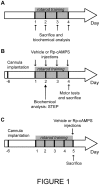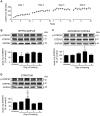Regulation of tyrosine phosphatase STEP61 by protein kinase A during motor skill learning in mice
- PMID: 24466306
- PMCID: PMC3900697
- DOI: 10.1371/journal.pone.0086988
Regulation of tyrosine phosphatase STEP61 by protein kinase A during motor skill learning in mice
Erratum in
-
Correction: Regulation of Tyrosine Phosphatase STEP61 by Protein Kinase A during Motor Skill Learning in Mice.PLoS One. 2016 Mar 9;11(3):e0150220. doi: 10.1371/journal.pone.0150220. eCollection 2016. PLoS One. 2016. PMID: 26960137 Free PMC article. No abstract available.
Abstract
Recently, striatal-enriched protein tyrosine phosphatase (STEP) and its upstream regulator protein kinase A (PKA) have been suspected to play a role in the intracellular mechanisms of fear conditioning and spatial memory. However, whether they contribute to the learning and memory of motor skills is totally unknown. In this study, we have investigated the role of STEP and PKA activities during motor skill learning associated with the accelerating rotarod task. We observed that learning the rotarod task differentially modulated the levels of phosphorylated STEP61 at serine 221, a site directly regulated by PKA, in the hippocampus, motor cortex and striatum. In a second set of experiments, we have pharmacologically inhibited PKA by the injection of Rp-cAMPS directly into the dorsal striatum of mice before rotarod trainings. PKA phosphorylation of STEP prevents the dephosphorylation of STEP substrates, whereas inhibition of PKA promotes STEP activity. Striatal PKA inhibitions dose-dependently impaired mice performances on the accelerating rotarod task. General motor abilities testing revealed an intact motor control in mice treated with 5 and 20 µg of Rp-cAMPS, but not at the highest dose of 40 µg. This suggested that motor learning was selectively affected by PKA inhibition at lower doses. Most notably, striatal inhibition of PKA reduced the levels of phosphorylated STEP61 at serine 221. Our data support that inactivation of STEP61 by the PKA activity is part of the molecular process associated with motor skill learning.
Conflict of interest statement
Figures





Similar articles
-
Intrastriatal inhibition of extracellular signal-regulated kinases impaired the consolidation phase of motor skill learning.Neurobiol Learn Mem. 2010 Jul;94(1):107-15. doi: 10.1016/j.nlm.2010.04.008. Epub 2010 May 4. Neurobiol Learn Mem. 2010. PMID: 20447478
-
Disrupting effect of drug-induced reward on spatial but not cue-guided learning: implication of the striatal protein kinase A/cAMP response element-binding protein pathway.J Neurosci. 2011 Nov 16;31(46):16517-28. doi: 10.1523/JNEUROSCI.1787-11.2011. J Neurosci. 2011. PMID: 22090478 Free PMC article.
-
Motor Skill Learning Is Associated with Phase-Dependent Modifications in the Striatal cAMP/PKA/DARPP-32 Signaling Pathway in Rodents.PLoS One. 2015 Oct 21;10(10):e0140974. doi: 10.1371/journal.pone.0140974. eCollection 2015. PLoS One. 2015. PMID: 26488498 Free PMC article.
-
HDAC inhibition facilitates the switch between memory systems in young but not aged mice.J Neurosci. 2013 Jan 30;33(5):1954-63. doi: 10.1523/JNEUROSCI.3453-12.2013. J Neurosci. 2013. PMID: 23365234 Free PMC article.
-
Striatal-enriched protein tyrosine phosphatase regulates the PTPα/Fyn signaling pathway.J Neurochem. 2015 Aug;134(4):629-41. doi: 10.1111/jnc.13160. Epub 2015 May 25. J Neurochem. 2015. PMID: 25951993 Free PMC article.
Cited by
-
STEP61 is a substrate of the E3 ligase parkin and is upregulated in Parkinson's disease.Proc Natl Acad Sci U S A. 2015 Jan 27;112(4):1202-7. doi: 10.1073/pnas.1417423112. Epub 2015 Jan 12. Proc Natl Acad Sci U S A. 2015. PMID: 25583483 Free PMC article.
-
Molecular causes of sex-specific deficits in rodent models of neurodevelopmental disorders.J Neurosci Res. 2021 Jan;99(1):37-56. doi: 10.1002/jnr.24577. Epub 2019 Dec 23. J Neurosci Res. 2021. PMID: 31872500 Free PMC article. Review.
-
Striatal-enriched protein tyrosine phosphatase controls responses to aversive stimuli: implication for ethanol drinking.PLoS One. 2015 May 20;10(5):e0127408. doi: 10.1371/journal.pone.0127408. eCollection 2015. PLoS One. 2015. PMID: 25992601 Free PMC article.
-
Genetic Deletion of Akt3 Induces an Endophenotype Reminiscent of Psychiatric Manifestations in Mice.Front Mol Neurosci. 2017 Apr 10;10:102. doi: 10.3389/fnmol.2017.00102. eCollection 2017. Front Mol Neurosci. 2017. PMID: 28442992 Free PMC article.
-
Hippocampal Egr1-Dependent Neuronal Ensembles Negatively Regulate Motor Learning.J Neurosci. 2022 Jul 6;42(27):5346-5360. doi: 10.1523/JNEUROSCI.2258-21.2022. Epub 2022 May 24. J Neurosci. 2022. PMID: 35610044 Free PMC article.
References
-
- Ungerleider LG, Doyon J, Karni A (2002) Imaging brain plasticity during motor skill learning. Neurobiol Learn Mem 78: 553–564. - PubMed
-
- Doyon J, Bellec P, Amsel R, Penhune V, Monchi O, et al. (2009) Contributions of the basal ganglia and functionally related brain structures to motor learning. Behav Brain Res 199: 61–75. - PubMed
-
- Willuhn I, Steiner H (2006) Motor-skill learning-associated gene regulation in the striatum: effects of cocaine. Neuropsychopharmacology 31: 2669–2682. - PubMed
-
- Wachter T, Rohrich S, Frank A, Molina-Luna K, Pekanovic A, et al. (2010) Motor skill learning depends on protein synthesis in the dorsal striatum after training. Exp Brain Res 200: 319–323. - PubMed
Publication types
MeSH terms
Substances
LinkOut - more resources
Full Text Sources
Other Literature Sources
Molecular Biology Databases

